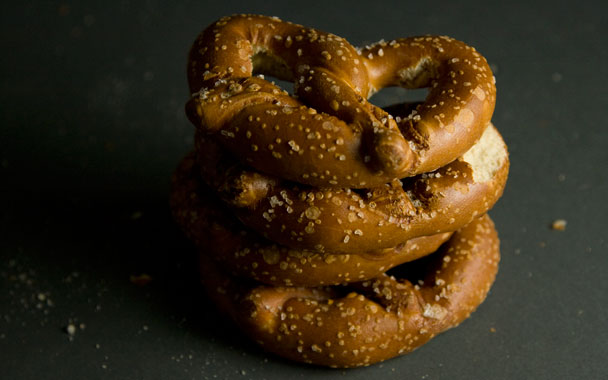On the streets of Hanover, Pennsylvania, and the rural two-lanes of the fertile countryside surrounding it, daybreak brings a curious spectacle. Fleets of boxy vehicles fan out until, by the arrival of rush hour, they are ubiquitous—stopped at traffic lights, idling in convenience-store parking lots, rumbling through farm-to-market crossroads. The name on the side of the truck might be Utz, or perhaps Martin’s or Snyder’s of Hanover, but the contents are something Americans have elevated to an art form: the snack-cheese curls, pork rinds, corn chips, pretzels and, of course, potato chips of every style and seasoning imaginable.
Now drive several dozen miles in almost any direction. The names on the trucks might change, but the scene is identical. In Lewistown, a few counties north, it’s Hartley’s Potato Chips. Next door in Lancaster County, it’s Herr’s and Wilbur Chocolate. Over in Reading, where for years an amusement park featured a ride called “The Pretzel,” the baked twists of salted wheat reign over what was once a town of thriving breweries. And in Hershey—well, that’s kind of self-explanatory.
The southern belly of Pennsylvania, where two cities (Philadelphia and York) served briefly as American capitals during the Revolutionary War, considers itself the nation’s capital of snacking. And it presents a compelling case.
At every turn, someone is making, distributing or touting items that you either unwrap or reach into a bag to consume. It ranges from the behemoth Snyder’s of Hanover, which makes 30 varieties of pretzels and runs pretzel machines 24 hours a day, to the storefront Revonah Pretzels a couple miles away (spell “Revonah” backwards), where the entire stock is fashioned by hand each morning atop a flour-dusted wood-and-metal table. Earlier this year, York County launched the “Sweet Treats and Salty Eats” trail, joining its neighbor, Lancaster, in making the manufacturing of munchies a tourist attraction. “You don’t come to central Pennsylvania on a low-carb diet, that’s for sure,” says Abby Crooks, of the York County Convention and Visitors Bureau. Tours of the region’s Wonka-like snackworks draw tens of thousands of people each year.
Any map of the Pennsylvania Snack Belt is arbitrary. It ripples out from the heavily German and Pennsylvania Dutch farming counties of York, Lancaster, and Berks, where the historical society recently staged an exhibit called “Beer and Pretzels.” It reaches west into Somerset County, home to the nationally distributed Snyder of Berlin; east to Philadelphia, where Tastykake rules and vendors sell chewy soft pretzels in paper bags on highway ramps; and as far north as Lewistown, where a mammoth foam-and-epoxy bag of Hartley’s potato chips descended from a fire-company ladder in the town square to ring in 2008.
No one has isolated exactly why this region is so snacky. For everyone who says it’s something in the water, someone else will insist it’s a natural outgrowth of a farming tradition rich with carbohydrates—winter wheat for pretzels and the ready availability of potatoes, not to mention the lard from pig farming that can fry ’em up. There are other theories, too. York County has a tradition of machine shops—Harley Davidson and Caterpillar shaped the industrial landscape here—and some snackmakers say that helped encourage factories. Lots of people attribute milk chocolate’s ubiquity to the proximity of a robust dairy-cow industry. The German and Pennsylvania Dutch tradition is often invoked, too. “The German people liked to work with their hands,” says Bob Wolfgang, the latest generation to run Wolfgang Candy, a charming boutique confectioner in York. Kevin Bidelspach, who runs Revonah Pretzels out of a tiny alley bakery, agrees. “If you had traveled these alleys in the 1930s, 40s, earlier,” he says, “you could have looked in the basements and seen people making snacks.”
Martin’s Potato Chips is also a family business. Nestled along U.S. 30, one of the country’s earliest federal highways, Martin’s is a 170-employee snack factory whose chief, Butch Potter, has worked the chip lines since his parents bought the business when he was 10. “I’ve seen people eat a pound of potato chips,” says Potter, whose brand has been served aboard Air Force One during both the Clinton and Bush administrations. In Pennsylvania, snacks, apparently, are a uniter, not a divider.
Pennsylvania Snack Facts:
· Americans eat two pounds of pretzels per person per year. Central Pennsylvanians eat three times as many.
· In pastures not far from its snack factory, Herr Foods raises Angus cattle—often feeding them “steer party mix,” a hodgepodge of chips and other crunchy savories that the company says “do not meet our quality specifications.”
· The low-water-content spuds used to make America’s favorite snack are called “chipping potatoes.”
· If you tour a snack factory, try to get a sample of a warm potato chip just off the frying-and-salting line. It’s crisp on the outside, still slightly soft in the middle, and it tastes buttery and melts in your mouth.
· Both Utz and Herr’s sell a potato chip flavored with the spices used to season crab meat. (Often referred to as “crab chips,” these snacks contain no actual crab.)
· Kettle-cooked chips are fried for a longer period in cooler oil to produce that crunchier, nuttier, more substantial taste and texture.

